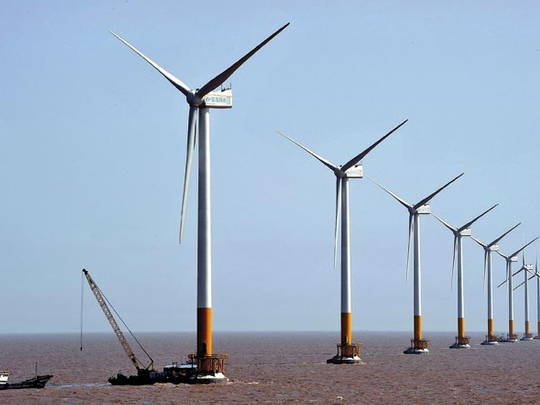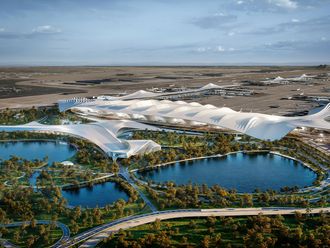
London: China WindPower Group, Iberdrola and Duke Energy will lead development of an estimated $65 billion (Dh239 billion) of wind-power plants this year that let utilities reduce their reliance on fossil fuels.
The estimate from Bloomberg New Energy Finance assumes a 9 per cent increase in global installations of wind turbines this year, adding as much as 41 gigawatts of generation capacity. That's the equivalent of 34 new nuclear power stations.
Utilities that built natural gas-fired generators during the last decade are increasingly erecting turbines and buying wind power from competitors, tapping a renewable-energy source as governments consider ways to penalise carbon-based fuels.
"Wind development is moving fast," James Rogers, chairman of Duke, which owns utilities in the U.S. Southeast and Midwest, said in London on March 18 at the Bloomberg New Energy Finance conference. "In the last 10 years, 90 per cent of plants we've built have been gas. I've used gas plants like crack cocaine."
Carbon emissions
While gas-fired plants are relatively cheap to build and pollute less than coal plants, they still emit carbon dioxide, which will carry higher costs if governments tighten environmental rules.
Last year, $63 billion was invested in turbines, adding 37.5 gigawatts of new capacity and bringing potential output of electricity from wind to 157.9 gigawatts, according to the Global Wind Energy Council, a Brussels-based industry group. A third of those turbines were installed in China, which doubled its capacity to 25 gigawatts.
Wind is gaining support as turbine costs fall and government stimulus money helps pay for the plants. Prices for turbines have declined by about 15 per cent to 1.05 million euros ($1.44 million) per megawatt over the past two years, according to William Young, an analyst at Bloomberg New Energy Finance.
"It makes sense and it makes money," said Michael Liebreich, founder of the London-based consultant bought by Bloomberg LP in December.
If this year's forecast holds, the new wind turbines may supply up to 12.3 million homes, less than the almost 33 million customers that the 34 nuclear plants would power with the same capacity, according to data from the US Department of Energy and American Wind Energy Association. Output from a nuclear plant is steady while turbines work only when the wind blows.
Worldwide investment in renewable-energy, which also includes solar and biomass facilities, may top $200 billion this year after outlays fell 6 per cent to $162 billion in 2009, Bloomberg New Energy Finance estimates.
That investment is moving ahead even after world leaders failed to reach a binding agreement limiting emissions from carbon-based fuels when they met in Copenhagen in December, Deutsche Bank Vice Chairman Caio Koch-Weser said.
The cost of carbon permits for December 2010 traded in Europe has fallen 3.2 per cent since that summit ended.
"The renewables story is gaining momentum independently now," Koch-Weser said in an interview at the same conference. "I see with many clients from China to California to India now a really good renewables paradigm shift happening."
This year, Duke plans to install 250 megawatts of wind equipment in the US, Rogers said. Bermuda-based China WindPower will invest about HK$900 million ($116 million) in 10 to 12 wind farms this year, nearly doubling its capacity, the company said on March 8.












